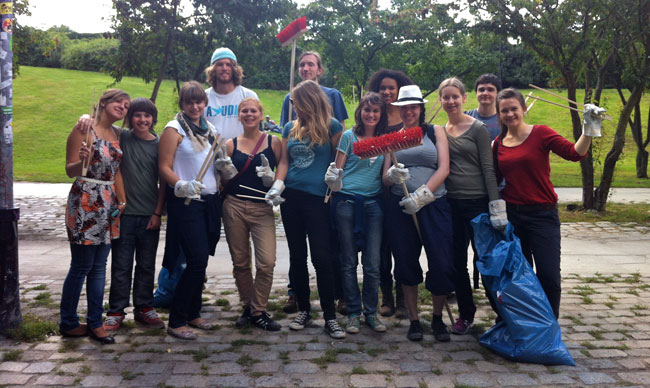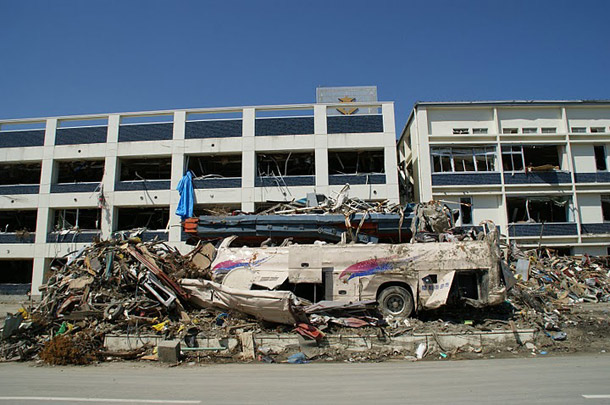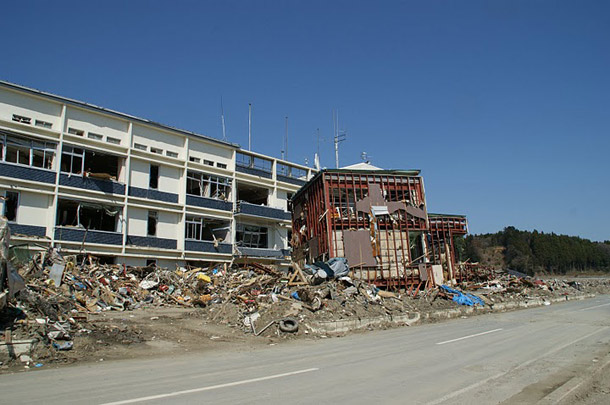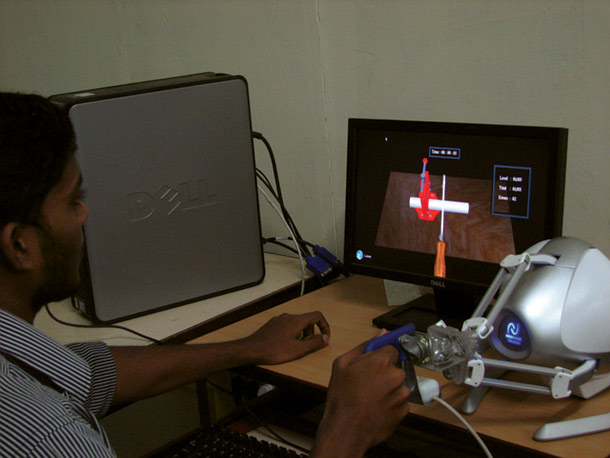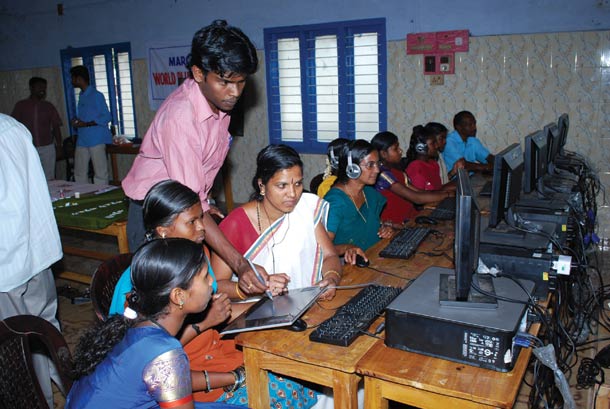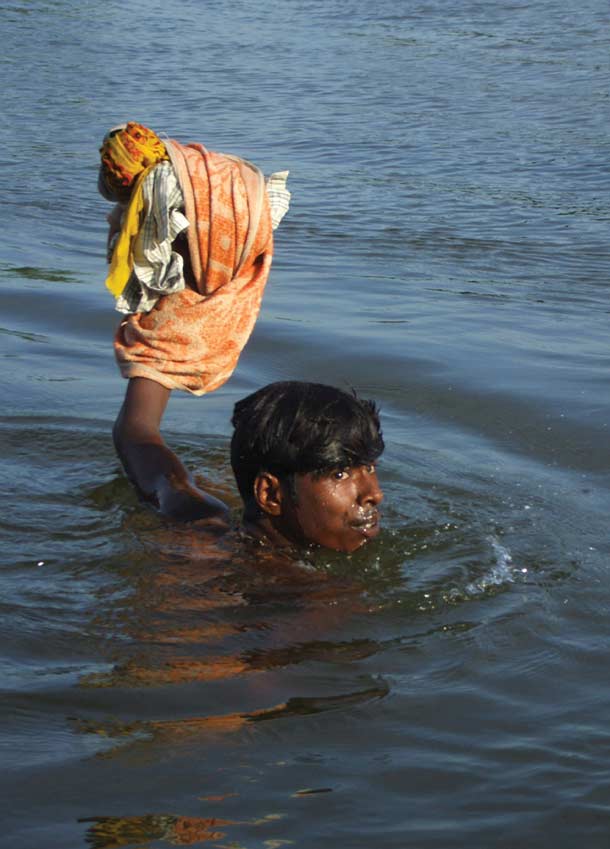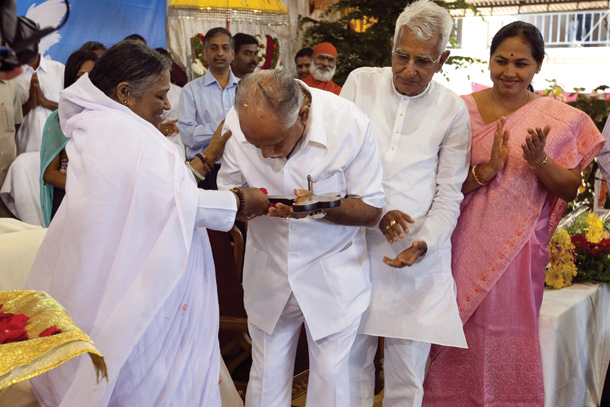On April 3rd, 2011, Koichi Kanematsu again accompanied a group of students, with whom in years past he has coordinated Embracing the World disaster relief and housing projects in India, back into some of the most severely damaged villages and towns Japan. This is their story.
7 April 2011
It was the night of the seventh of April, and I had just fallen asleep in our tent. We were camping along with hundreds of other volunteers on the lawn of a local university, which had been transformed into the headquarters for the relief efforts in Ishinomaki. Half an hour before midnight, an earthquake of magnitude 6.0 suddenly hit. It felt as if the earth was pushing me straight up. It seemed like it lasted forever. I’ve experienced earthquakes before, but they have always been sort of a rolling sensation. This time, the earth was pitching up and down, intensely.
I crawled out of my sleeping bag and went outside. A loud air-raid-type siren started to sound, and an announcement was made, alerting everyone to the possibility of another tsunami. Volunteers crawled out from each tent, their flashlights scanning the night. Despite the potential magnitude of the situation, all the volunteers demonstrated the same noble-mindedness that had brought them from all over Japan to offer their service to the tsunami-stricken area. They remained calm and proceeded in an orderly fashion to the third floor of the university building.
In the dark of the university building, we all sat, quietly holding our breath. No one knew what was going to happen. Eventually someone brought in a radio and tuned in to an emergency-information channel. After about an hour, the tsunami alert was cancelled and we all returned to our tents. The epicenter had been near Sendai, but fortunately there was no real damage.
***
On the fourth of April, we had returned to Ishinomaki. There were 51 volunteers this time—28 IVUSA (International Volunteer Student Association) members and 20 students from Kokushikan University Sports Medicine Department. After we arrived, we set up a large tent to use as our head office and one for cooking. Next to them, we set up about nine more tents to sleep in. If we really pack ourselves in—like sardines in a can—we we able to fit five or six of us in a tent. But there was no room to even roll over!
The first thing we did was to remove dirt from houses in an area called Kawakita. Before we started working, the mayor of Kawakita spoke to all of us. He told us that 140 of the village’s 160 elementary-school students were still missing. When the earthquake struck, they had all been lead out of the school into the schoolyard, only to be washed away when the ocean rolled in. He warned us that there was a chance we might come across some dead bodies as we worked. This was hard for the volunteers to hear, and I could tell they had to fight to keep themselves together emotionally.
The volunteers divided into five groups of nine members each. Each group had a group leader. Each group focused on certain houses, sweeping out all the dirt and bringing out all the chairs, tables, futons, TVs, laundry machines, dressers, etc. Looking at the walls of the houses, you could see the high-water mark—almost six feet up.
At the house at which I was to help, a young mother and her teenage daughter were quietly carrying out all their heavy furniture. Dirt streaked the mother’s cheek next to the dust-mask she wore. I joined them and helped them carry out all the tatami mats, which were extremely heavy, as they were soaked with water. We then took out the rest of the furniture as well. We found a tricycle and fashioned it into a cart and used it to haul garbage out to the roadside. Then, we swept all the dirt out of their garage.
At first, the facial expressions of the mother and daughter were a bit stiff, but since the students kept speaking to them in lively voices, they gradually started to relax and show smiles. I could feel their hearts—which had been somewhat hardened due to the swift blow of the tsunami—slowly soften in response to the students’ dedication, vigor and humor.
Some students became quite close with the families they helped. Many of the families invited the volunteers to return the next year to go fishing with them. The work, however, was very intense. Under normal circumstances, no one would enjoy such burdensome work—carrying heavy material all day, sweeping stinky dirt. Regardless due to the students’ determination to complete the work and thereby help people so immersed in sorrow, everyone was able to maintain their energetic spirit and enthusiasm.
After two days doing such work, the volunteer organizers asked us to move to another village, but the students wanted to continue in Kawakita, as they had established a special bond with the people there. They even began chanting “Let’s finish it all! Let’s finish it all! Let’s finish it all!” At that moment, the volunteers were glowing so beautifully—to me, to the people in the area, and to everyone. They were burning their wonderful being into our eyes.
Feel other’s sorrow as my own sorrow. One for all, all for one. Put yourself aside and think about others and act for them. If you do so, you can feel much deeper joy and happiness than you attain from filling your own desires.
***
On the second day, the IVUSA representative, a staff member, two students and I paid a visit to a town called Minami-Sanriku. There, we picked up various required supplies, like soap, shampoo and toothbrushes. We also took 20 cases of vegetable juice and cough drops, as many of the volunteers had developed sore throats due to sleeping in the chill coastal air. When we left, our car was fully loaded.
Every single house on the coast in Minami-Sanriku had been washed away. In fact, it was hard to believe that a village had once been there. It was nothing but wreckage—demolished cars and scraps of who-knows-what covered the ground. The Self Defense Military, from which we obtained our supplies, was using cranes and bulldozers to clear the area. The police from various prefectures were also helping. It was simply too dangerous an environment for mere volunteers.
Walking around the town saw all the different ways in which various groups and institutions were providing service. A cell-phone company had set up a table for charging mobile phones. Israeli Army troops along with the Ministry of Health, Labor & Welfare had set up a medical clinic, collaborating with Japanese medical teams. Big Israel soldiers walking amongst the rural, old ladies—stooped with age—somewhat took me aback. A truck with a Ramen Noodle logo painted on the body was delivering noodles to people.
One of the IVUSA members’ grandparents lived in the town, and we wanted to visit them. As the village was totally decimated, the student had trouble finding her grandmother’s house. As we travel along the beach, the impact of how horribly mangled the town was, really hit us. I couldn’t help but marvel at the power of Nature and our powerlessness in its face.
Eventually we located the house. As it was located on a hill, it had not been damaged. However, since there was no running water, they had to pump water from a well and carry it back home. When we pulled up to the house, the grandmother was standing outside. The way that the student rushed out from the car and ran to her grandmother left a heartwarming impression on me. Her grandmother had a big smile on her face. It was a slightly modest, but moving reunion. We spent some time with them, talking. Before we left, I asked the grandmother if she was receiving relief goods. She modestly answered that she had enough. However, since we were well aware that everyone was struggling with limited supplies, we left them mineral water and vegetable juice.
***
On the third day, we were asked to aid Otschi-Cho, in the prefecture of Iwate. An IVUSA staff member who is very experienced in disaster relief joined me and two other students. Just like Minami-Sanriku, Otsuchi-Cho seemed to have vanished.
When we arrived at Otsuchi-Cho Town Assembly Hall, there were many volunteers gathered there. After getting in touch with our local contact, we were taken to our assigned house. The work was similar to that in Kawakita—sweeping dirt from house and removing furniture. The flooring also had to be ripped out, and the sludge gathered underneath the floorboards scraped away. The IVUSA expert explained that sludge not smells bad but also carries bacteria and other vectors for disease. In rural villages like these, many of the toilets don’t properly flush. During the flooding, human waste is thus mixed with the flood water. This can lead to outbreaks of disease. Termites can also infest the floorboards. Unless it is dealt with now, the houses could become structurally unsound very quickly.
Another nonprofit organization had organized a Chinese restaurant to supply food for the villagers. In order to do so, a tent needed to be erected in a nearby parking lot, and volunteers were also required to cook, serve and maintain the queue. The restaurant had brought pork and sweet-bean dumplings. These were cooked onsite and served to the people still steaming. Pork miso soup was also provided.
The people staying in their houses—be they whole or half-collapsed—had less access to information regarding the availability of food and other relief supplies than those staying at the refugee camps. I wanted to make sure they knew about the Chinese food being prepared for them, so I got on a collapsible bicycle I had brought with me and visited each house. I knocked on as many doors as possible, and called out in front of the houses, hoping that my efforts might allow one more person to come and avail themselves of the delicious soup and dumplings.
An old lady, bent with age, was sitting in her house all alone. When I walked up to her door, she got up and began carefully walking across the ply-board that now covered her recently stripped floor. I insisted, “Grandma, please sit down, sit down!” But in spite of what I said, she kept walking towards me. I told her, “We are making pork miso soup. Please come get it.” The lady smiled delightfully and said, “Thank you very much for your trouble. Thank you so much,” and bowed her head again and again, joining her hands in prayer.
At another household, a young boy, who looked like an elementary-school student, came out. I told him about the food. He excitedly called out to his mother in the back of the house, “We can get hot pork miso soup! Let’s go!”
I also went over to where the people were standing in line to receive relief goods at the assembly hall. I called out: “We have pork miso soup here! Please come! It is very hot and delicious!” Many people replied to me with big voices saying, “Thank you so much, thank you so much!” and bowed to me again and again. I did not feel worthy of such appreciation. I could only leave there, bowing back to them, grinning with embarrassment. These small encounters and interactions with people brought me much joy and happiness.
A young couple was busily taking dirt out of their house in the rain. Their recently built, and once splendid, home was now tilted and half-collapsed. A flipped-over car was leaning against their wall. They were working quietly. I called out to them. They looked at me, and I could see the exhaustion on their faces.
When I told them about the food, their eyes brightened and they bowed to me and said, “Thank you for your trouble. Yes, we will be there to get some food, then.” They expressed their appreciation in a Miyagi dialect, and I felt that we instantly shared something no words can explain.
When I returned to the impromptu kitchen, I saw many people lined up to get lunch. It was nice to see them satiating their hunger on the good food. Many stomachs—and hearts—were filled.
That day, for the first time since coming to the tsunami-stricken area, I broke down in tears. I have no words to describe it. I had never become so emotional as I did that day. Not even when I first saw the devastation. Perhaps it was having had so many opportunities to interact with directly with the affected people that had induced the reaction in me.
I remembered Amma’s words: “Set aside your own issues for which you would ask ‘Why me, why me?’ and give priority to thinking about others, and their needs. There, in Otsuchi-Cho, I felt the power of this teaching. Through lending the small help I could, I received joy and happiness and touching experiences that never could have been attained through fulfilling my own selfish desires.
Those were short conversations, but everyone showed their joy without any hesitation and expressed their appreciation. Some even cheered me up. Everyone I met was very polite. They looked firmly into my eyes and gave me truly pleasant smiles, despite their terribly difficult and painful situations. I was experiencing their sorrow as my own. My heart was deeply touched by their kindnesses and strength.
As a mere individual, my ability to help others is quite limited. I sometimes become frustrated about this, thinking that I should be able to do more for them. However, in some way, by putting myself in the shoes of the disaster-affected people, I was able to share my heart with them, and this seemed to make a real impact. It didn’t take much—a sincere smile, interacting with care.
I shed my tears in the rain. However, I felt somehow very warm in my heart, immersed in a feeling of wonder, as if I was being held in Amma’s lap. I would give anything to help others, as one of Amma’s tools, in her hand, with her compassion and love.
One more memory I would like to share. At one point, we were helping a 70-year-old lady, who lived all alone in a small one-story house. We carried out her furniture, tatami mats and other household items. We also stripped her floor, scraped off the sludge and sprinkled lime. We then made a floor frame and put plywood boards on top it. The old lady was so charming and playful. She immediately hit it off with the students. Everyone was joking and having fun. When we had completed the work, loathing to part, the volunteers took commemorative pictures and exchanged email addresses and telephone numbers. The old lady couldn’t hold back her tears.
After we all got into the car and began to drive away, I watched the charming grandmother in the rearview mirror. She was smiling and waving goodbye to us. Watching her, something warm bubbled up in my heart. I watched her until she disappeared.




